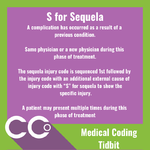Many codes in Chapter 19 of ICD-10-CM (Injury, Poisoning, and Certain Other Consequences of External Causes (S00-T88)) require a 7th character to identify the episode of care. With the exception of the fracture codes, most Chapter 19 codes have three 7th character values.
Perhaps the most common sequela is pain. Many patients receive treatment long after an injury has healed as a result of pain. Some patients might never have been treated for the injury at all. As time passes, the pain becomes intolerable and the patient seeks a pain remedy.
A late effect can occur only after the acute phase of the injury or illness has passed; therefore, you cannot report a code for the acute illness and a code for the late effect at the same encounter, for the same patient. The only exception occurs if both conditions exist (for example, the patient has a current cerebrovascular condition and deficits from an old cerebrovascular condition).
When reporting sequela(e), you usually will need to report two codes. The first describes the condition or nature of the sequela(e) and second the second describes the sequela(e) or “late effect.” For example, you may report M81.8 Other osteoporosis without current pathological fracture with E64.8 Sequelae of other nutritional deficiencies (calcium deficiency).
If a late effect code describes all of the relevant details, you should report that one code, only (e.g., I69.191 Dysphagia following nontraumatic intracerebral hemorrhage).
For example: A patient suffers a low back injury that heals on its own. The patient isn’t seeking intervention for the initial injury, but for the pain that persists long after. The chronic pain is sequela of the injury. Such a visit may be reported as G89.21 Chronic pain due to trauma and S39.002S Unspecified injury of muscle, fascia and tendon of lower back, sequela.
A sequela character (“S”) is applied for complications or conditions that arise as a direct result of a condition or injury (in ICD-9, these were known as “late effects”). Examples may include joint contracture after a tendon injury, hemiplegia after a stroke or scar formation following a burn.
A late effect can occur only after the acute phase of the injury or illness has passed; therefore, you cannot report a code for the acute illness and a code for the late effect at the same encounter, for the same patient. The only exception occurs if both conditions exist (for example, the patient has a current cerebrovascular condition and deficits from an old cerebrovascular condition).
When reporting sequela(e), you usually will need to report two codes. The first describes the condition or nature of the sequela(e) and the second describes the sequela(e) or “late effect.” For example, you may report M81.8 Other osteoporosis without current pathological fracture with E64.8 Sequelae of other nutritional deficiencies (calcium deficiency).
If a late effect code describes all of the relevant details, you should report that one code, only



 www.aapc.com
www.aapc.com
Defining Sequela
ICD-10-CM says the seventh character S is “for use for complications or conditions that arise as a direct result of an injury, such as scar formation after a burn. The scars are sequelae of the burn.” In other words, sequela are the late effects of an injury.Perhaps the most common sequela is pain. Many patients receive treatment long after an injury has healed as a result of pain. Some patients might never have been treated for the injury at all. As time passes, the pain becomes intolerable and the patient seeks a pain remedy.
A late effect can occur only after the acute phase of the injury or illness has passed; therefore, you cannot report a code for the acute illness and a code for the late effect at the same encounter, for the same patient. The only exception occurs if both conditions exist (for example, the patient has a current cerebrovascular condition and deficits from an old cerebrovascular condition).
When reporting sequela(e), you usually will need to report two codes. The first describes the condition or nature of the sequela(e) and second the second describes the sequela(e) or “late effect.” For example, you may report M81.8 Other osteoporosis without current pathological fracture with E64.8 Sequelae of other nutritional deficiencies (calcium deficiency).
If a late effect code describes all of the relevant details, you should report that one code, only (e.g., I69.191 Dysphagia following nontraumatic intracerebral hemorrhage).
For example: A patient suffers a low back injury that heals on its own. The patient isn’t seeking intervention for the initial injury, but for the pain that persists long after. The chronic pain is sequela of the injury. Such a visit may be reported as G89.21 Chronic pain due to trauma and S39.002S Unspecified injury of muscle, fascia and tendon of lower back, sequela.
A sequela character (“S”) is applied for complications or conditions that arise as a direct result of a condition or injury (in ICD-9, these were known as “late effects”). Examples may include joint contracture after a tendon injury, hemiplegia after a stroke or scar formation following a burn.
A late effect can occur only after the acute phase of the injury or illness has passed; therefore, you cannot report a code for the acute illness and a code for the late effect at the same encounter, for the same patient. The only exception occurs if both conditions exist (for example, the patient has a current cerebrovascular condition and deficits from an old cerebrovascular condition).
When reporting sequela(e), you usually will need to report two codes. The first describes the condition or nature of the sequela(e) and the second describes the sequela(e) or “late effect.” For example, you may report M81.8 Other osteoporosis without current pathological fracture with E64.8 Sequelae of other nutritional deficiencies (calcium deficiency).
If a late effect code describes all of the relevant details, you should report that one code, only
Coding Corner: “Initial” vs. “subsequent” vs. “sequela” in ICD-10-CM coding
CPR’s “Coding Corner” focuses on coding, compliance and documentation issues relating specifically to physician billing. This month’s tip comes from G. John Verhovshek, the managing editor for AAPC...
www.cmadocs.org


When Is an Injury Initial, Subsequent, or Sequela?
Many injury codes in Chapter 19 of ICD-10-CM require a 7th character to identify the episode of care: initial, subsequent, or sequela.


